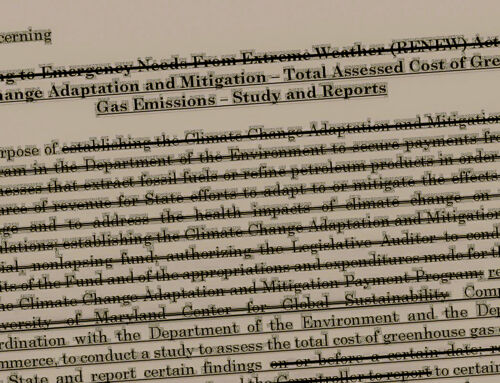View by Topic
Recent Articles
-
Maryland is About to Regulate Mold But is the Cart Before the Horse?Saturday, May 10th, 2025
-
New Environmental Laws from the 2025 Maryland Legislative SessionSaturday, April 26th, 2025
-
Migratory Bird Treaty Act Does Not Prohibit Incidental Take – AgainSaturday, April 19th, 2025
-
President Trump’s Bold Step to Rein in State Overreach in Climate ChangeSaturday, April 12th, 2025
View by Month/Year
“Green Building Law Update” Headlines
Recent Articles & News from
Stuart Kaplow’s blog
at GreenBuildingLawUpdate.com
- Maryland is About to Regulate Mold: But is the Cart Before the Horse? May 11, 2025
- BEPS Redux: The Most Far Reaching Environmental Legislation of the 2025 Maryland General Assembly May 4, 2025
- New Environmental Laws from the 2025 Maryland General Assembly Session April 27, 2025
- Migratory Bird Treaty Act Does Not Prohibit Incidental Take – Again April 20, 2025
Subscribe to the Green Building Law Update!
Stuart Kaplow brings his expertise and extensive experience to the table with his unique digital publication, "Green Building Law Update". Subscribers receive regular updates to keep them informed about important issues surrounding Environmental Law, Green Building & Real Estate Law, as well as the emerging demand for Environmental Social Governance (ESG).
Get fresh content through the lense of Stuart Kaplow's cutting-edge expertise, innovative commentary and insider perspective. Don't miss another issue! Subscribe below.

A Quick Refresher on the Science of Greenhouse Gas
With the federal government and state of Maryland each having announced within days of each other, the mandated disclosure of greenhouse gas (GHG) emissions, we have received, maybe not surprising, many calls in the last two weeks inquiring “what are GHGs?” and “what are Scope 3 GHG emissions (.. which are proposed to be a component of the SEC required disclosures but not the Maryland program)?”
On the cusp of these two regulatory programs, pushing broad sectors of the economy to the next frontier in innovation, SEC Climate Risk Rule is Transformative at a Cost and Maryland Resets its Trajectory with Greenhouse Gas Reduction Law, a quick 800 word refresher about GHG emissions makes an ideal blog post.
But make no mistake, the larger issue is the regulation for the first time of GHGs (including carbon) which will literally change the structure of the global economy, our political order, market capitalism and even our biological selves.
Simply put, gases that trap heat in the atmosphere (.. maintaining the Earth’s temperature and contributing to global warming) are called greenhouse gases. The U.S. EPA tells us succinctly, ..
Carbon dioxide is the primary greenhouse gas emitted through human activities. In 2020, carbon dioxide accounted for about 79% of all U.S. greenhouse gas emissions from human activities. (Yes, water vapor is the most abundant GHG in the atmosphere, but it is a different animal and water vapor does control Earth’s temperature but, there is never a change in the amount of water on Earth.)
In 2020, methane accounted for about 11% of all U.S. greenhouse gas emissions from human activities. Human activities emitting methane include leaks from natural gas systems and the raising of livestock.
In 2020, nitrous oxide accounted for about 7% of all U.S. greenhouse gas emissions from human activities. Human activities such as spreading fertilizer, fuel combustion, wastewater management, and industrial processes are increasing the amount of nitrous oxide in the atmosphere.
Since the Industrial Revolution small amounts of other man made gases have been added to the mix.
Concentration, or abundance, is the amount of a particular gas in the air. Larger emissions of greenhouse gases lead to higher concentrations in the atmosphere. Greenhouse gas concentrations are measured in parts per million, parts per billion, and even parts per trillion. One part per million is equivalent to one drop of water diluted into about 13 gallons of liquid.
Surprising to some, carbon dioxide emissions in the U.S. decreased by about 8% between 1990 and 2020. Since the combustion of fossil fuel is the largest source of greenhouse gas emissions in the United States, changes in emissions from fossil fuel combustion have historically been the dominant factor affecting total U.S. emission trends. Changes in GHG emissions from fossil fuel combustion are influenced by many factors, including population growth, economic growth, changing energy prices, new technologies, changing behavior, and seasonal temperatures. In 2020, the decrease in carbon dioxide emissions from fossil fuel combustion corresponded with a decrease in energy use as a result of decreases in economic, manufacturing, and travel activity in response to the Coronavirus pandemic, in addition to a continued shift from coal to less carbon intensive natural gas in the electric power sector.
Today, without new technologies, there is little dispute the most effective way to reduce GHG emissions, including carbon dioxide, is to reduce fossil fuel consumption.
But reduce what to what? EPA suggests there were 5,981 million metric tons of greenhouse gas emissions in 2020. One million metric tons is equal to about 2.2 billion pounds, or 1 trillion grams. For comparison, a small car is likely to weigh a little more than 1 metric ton. Thus, a million metric tons is roughly the same mass as 1 million small cars!
And to have an impact those numbers need to be reduced. Appreciate that Scope 1 greenhouse (GHG) emissions are direct emission that occur from sources that are controlled or owned by an organization (e.g., emissions associated with fuel combustion in boilers, furnaces, vehicles), but are modest in abundance.
Scope 2 emissions, which are generally greater in contribution, are indirect GHG emissions associated with the purchase of electricity, steam, heat, or cooling. Although scope 2 emissions physically occur at the facility where they are generated, they are accounted for in an organization’s GHG inventory because they are a result of the organization’s energy use.
And Scope 3 emissions are the result of activities from assets not owned or controlled by the reporting organization, but that the organization indirectly impacts in its value chain. Scope 3 emissions include all sources not within an organization’s scope 1 and 2 boundary. (The scope 3 emissions for one organization are the scope 1 and 2 emissions of another organization.) Scope 3 emissions, also referred to as value chain emissions, often represent the majority of an organization’s total GHG emissions, both upstream and downstream of the organization’s activities.
With that refresher you can now ‘talk the talk’ of GHG emission regulation including in the context of this, now emergent effort to regulate GHGs. And please consider being an active participant in the discussions including commenting on proposed regulation, including as suggested in our post last week, You Should Comment on the SEC’s Transformative Proposed ESG Rule.
And we are happy to talk with you about how the new ESG laws, including the associated opportunities and risks in the mandates requires business disclosures of GHG emissions. We have been doing this GHG work since 2005.
Because, as we see it, we can repair the world and exponential growth across the globe can continue ss long as in a rush to save the planet, we don’t weaponize GHG emissions and turn the regulations on ourselves destroying civilization and our very way of life.









